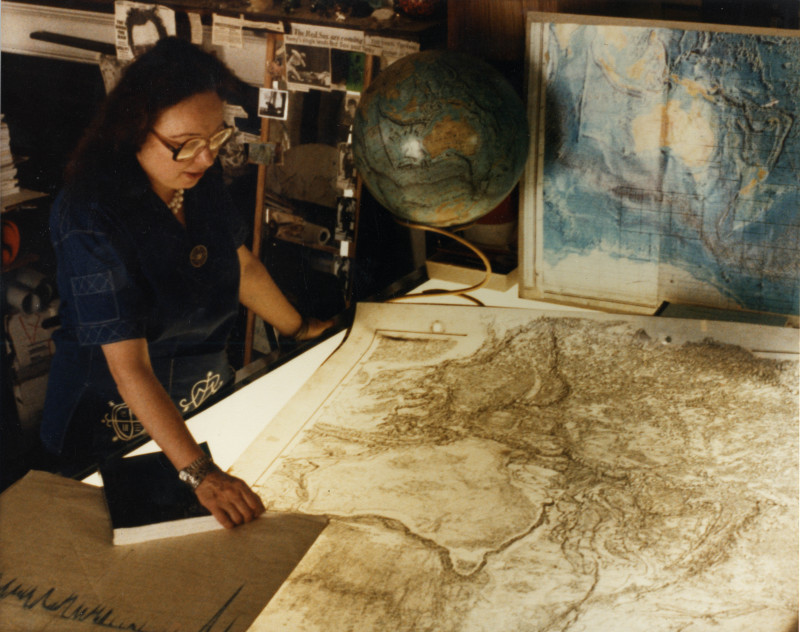The American geologist and oceanographer Marie Tharp (July 30, 1920 – August 23, 2006) in collaboration with Bruce Heesen, created the first scientific map of the Atlantic Ocean.
In the American geologist and oceanographer Marie Tharp honors Google with today’s Doode.
Marie Tharp (July 30, 1920 – August 23, 2006) in collaboration with Bruce Heesen, created the first scientific map of the Atlantic Ocean. Tharp’s work revealed the presence of the Mid-Atlantic Ridge, causing a radical change in theory in the Earth sciences, leading to the acceptance of the theory of plate tectonics and continental drift.
Tharp was born in Ypsilanti, Michigan. Her mother, Bertha, was a teacher of German and Latin. Her father, William, made soil classification maps for the US Department of Agriculture.
Tharp graduated from Ohio University in 1943 with degrees in English and music and four certifications. World War II meant that more women were being recruited into previously male-dominated professions such as petroleum geology, and, having taken geology classes in Ohio, Tharp was recruited to the University of Michigan’s Ann Arbor petroleum geology program, where she completed a master’s degree. Tharp’s leap into a career in the earth sciences is extraordinary, given the few women in the field — women earned less than 4 percent of all earth science PhDs at the time. Tharp took a job at Standard Petroleum and Natural Gas in Tulsa, but found it disappointing, earning a bachelor’s degree in mathematics from the University of Tulsa while working as a geologist for the Stanolint oil company.
Moving to New York in 1948, Tharp was hired by Morris Ewing at the Lamont Geological Laboratory (now the Lamont-Doherty Earth Observatory) at Columbia University, initially as a general technical designer. There, Tharp met Bruce Heesen (pictured), and in their initial collaboration they used photographic data to locate an aircraft shot down during World War II. Tharp was employed and continuously promoted from 1952 until 1968, when her position was moved to subsidized status due to a lab policy involving Heesen (Tharp remained in a subsidized position until Heesen’s death in 1977). Later, they began working together to map the topography of the ocean floor. For the first 18 years of their partnership, Heesen collected bathymetric data aboard the research vessel Vima, while Tharp drew maps based on data, as women were still barred from working on ships at the time. Although she was limited from conducting research at sea early in her career because of her gender, she was later able to take part in a data-gathering expedition in 1965. Tharp independently used data collected by the Woods Oceanographic Institution’s research vessel Atlantis. Hole, and seismographic data from submarine earthquakes. Her collaboration with Heesen marks the first systematic attempt to map the entire ocean floor.
In 1952, Tharp identified the Mid-Atlantic Rift for the first time. Heesen was initially unconvinced, as the idea would support continental drift, then a controversial theory. Instead, he once again supported the expansion of the Earth, ridiculing Tharp’s theory as “women’s talk”. However, under Tharp’s guidance, Heesen eventually turned to the alternative theories of plate tectonics and continental drift, and they published their first physiographic map of the North Atlantic in 1957. However, Tharp’s name does not appear on none of the major scientific papers on lithospheric plates, which Heesen and others published between 1959 and 1963. Then, in collaboration with the Austrian landscape painter Heinrich Beran, they published their map of the entire ocean in 1977 (coincidentally , is also the year of Hezen’s death).
After Heesen’s death, Tharp continued to serve on the faculty of Columbia University until 1983, after which she operated a map distribution business in South Nyack during her retirement. Tharp donated her map collection and notes to the Map and Geography Division of the Library of Congress in 1995. In 1997, Tharp received a double honor from the Library of Congress, where she was named one of the four greatest cartographers of the 20th century and the her work was included in an exhibition celebrating the 100th anniversary of the Department of Geography and Maps. In 2001, Tharp was awarded the first annual Lamont-Doherty Legacy Award for her work as a pioneer in oceanography.
In 2009, Google Earth included Marie Tharp’s historical chart layer, allowing Google Earth users to view Tharp’s ocean chart. In 2013, author Hallie Felt published a biography of Marie Tharp titled Bulletproofing: The Story of the Remarkable Woman Who Mapped the Ocean Floor. The book was cited by the New York Times for its standing as an “eloquent testament to Tharp’s importance and the power of Felt’s imagination.”
With information from wikipedia.gr
Read the News today and get the latest news.
Follow Skai.gr on Google News and be the first to know all the news.
With a wealth of experience honed over 4+ years in journalism, I bring a seasoned voice to the world of news. Currently, I work as a freelance writer and editor, always seeking new opportunities to tell compelling stories in the field of world news.












